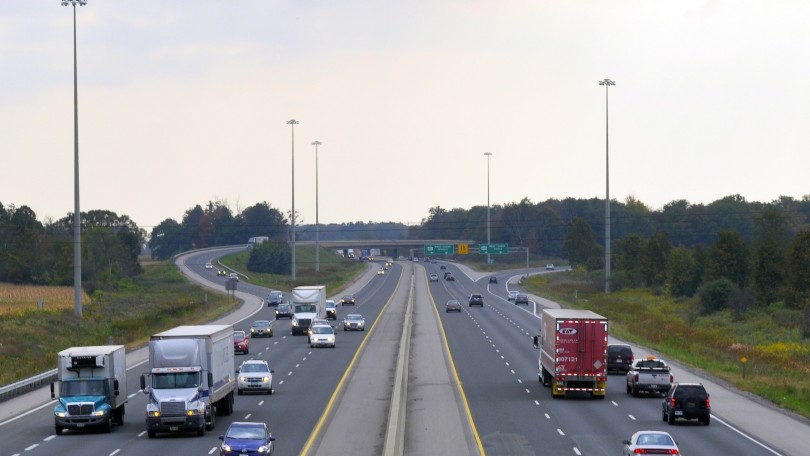Innovation Brief: Needed: A Fresh Approach to Funding America’s Infrastructure (2/13/15)
Presented at the Congressional Staff Briefing sponsored by the Republican Study Committee, February 13, 2015
As the deadline for reauthorizing the federal surface transportation program draws nearer, the Obama Administration’s proposal to renew the program for six years has been dealt a serious blow. The Republican leadership in Congress has declared the proposed method of funding the program as a “nonstarter.” At a February 11 hearing on the bill, Rep. Peter De Fazio (D-OR), ranking Democrat on the House Transportation and Infrastructure (T&I) Committee, joined the skeptics. “We aren’t going to see mandatory repatriation out of this Congress…and we’re not going to see it by May 31, so do we have a backup plan?” he asked Transportation Secretary Anthony Foxx.
Congressman DeFazio was referring to the Administration’s proposal to fund the transportation program through a mandatory 14% tax on accumulated overseas earnings of U.S. companies, allowing for their repatriation. The tax would bring in $238 billion according to the Administration’s calculations. Combined with $240 billion from the Highway Trust Fund as proposed by the White House, it would fund a $478 billion six-year surface transportation bill. At $80 billion a year, the annual rate of spending under the Administration’s proposal would increase by a hefty 51% over spending under the current law.
Looking for solutions
While a spending increase of that magnitude is being dismissed as totally unrealistic, the money needed to keep the federal transportation program funded at the going rate is still substantial. The Congressional Budget Office estimates that it would require an extra 13 billion each year just to maintain the program at the current spending level. The Trust Fund shortfall is produced by a mismatch between a spending level of $53 billion/year and a revenue stream from the federal gas tax and interest of only $40 billion/year. A six-year program would be faced with a shortfall requiring $78 billion in subsidies..
An obvious solution to eliminating this mismatch would be to raise the federal gas tax. This, in fact, is what Rep. Earl Blumenauer’s (D-OR) bill (HR 680) is intended to accomplish with a 15 cent per gallon increase over three years. At a press conference, Blumenauer pronounced a gas tax increase as the solution that is “the simplest, easiest to pass, and the only one giving long term stability.”
But for better or for worse, a gasoline tax increase has been firmly ruled out both by the Republican House leadership and the White House. Speaker Boehner thinks there just aren’t enough votes in the House to pass it. The administration is opposed because a gas tax increase would fall most heavily on those who can least afford it. Both parties cite public opinion surveys that consistently have shown a low level of popular support for a boost in the federal gas tax.
An alternative way to cover the Trust Fund shortfall— through an infusion of general fund revenue— presents its own problems. Although general funds have been used to shore up the Highway Trust Fund in the past (to the tune of $62 billion), they require “offsets” or “pay-fors” that have been increasingly difficult to justify—and that critics have derided as “budget gimmicks.”.
While some observers believe there is still a possibility of eventual progress on comprehensive tax reform that would help pay for the shortfall in the Highway Trust Fund, the expiration of the current transportation bill at the end of May will probably require Congress to find a more immediate way of funding the surface transportation program.
Shifting a larger share of funding to the states
With no other sources of funds in sight, the most pragmatic and timely approach might be to shift a larger share of funding responsibility to the state and local level. It’s a solution that has been gaining traction not just among conservative Republicans but also with the transportation advocacy group, Transportation for America (T4America).
“Prospects of returning to robust national investment are uncertain at best. States that want to continue investing will have to explore new ways to raise funding for transportation on their own,” said T4America’s Director, James Corless in announcing the launch of an initiative to support efforts to raise transportation funding through state legislation http://t4america.org/2014/11/
The movement toward more fiscal autonomy resonates in state capitals. Governors and state legislatures deem the prospects for future federal funding as highly uncertain and are seeking to place their transportation programs on a more independent fiscal footing.
They are employing a variety of methods to raise money, such as increasing state gas taxes, passing bond referenda, enacting dedicated sales taxes for transportation, increasing reliance on highway tolls and financing large-scale construction projects with long term credit. Also gaining acceptance are public-private partnerships utilizing private capital, and highway tolling concessions (see below).
In the past two years twelve states enacted new revenue sources for transportation and at least 20 more states are currently considering transportation funding legislation according to the Council of State Governments (“States to Watch in 2015: Transportation Funding,” CSG Knowledge Center.) A total of 46 transportation funding bills have been introduced in 2015, reports ARTBA’s Transportation Investment Advocacy Center which tracks transportation funding initiatives at the state level. Collectively, these measures promise to generate billions of additional dollars for state and local transportation programs.
New state revenue could reduce the need for federal funds
With state transportation revenue on the rise, goes the argument, states can assume more funding responsibility for local infrastructure and significantly reduce the annual $13 billion shortfall in the Highway Trust Fund. This is not about devolution, contend advocates of this approach. It’s about a judicious reallocation of federal-state responsibilities, with the federal government able to refocus its gas tax revenue entirely on infrastructure of national significance (notably the Interstate Highway network), thanks to the states’ enhanced fiscal capacity to take care of its highways, bridges and other local transportation needs.
Exactly by how much could the current trust fund shortfall be reduced because of higher levels of state transportation revenue? It’s a question that the congressional tax-writing committees responsible for funding the next transportation bill will surely wish to explore thoroughly.
###
The “Can-Do” States
As of press time, the following states have taken steps to raise transportation revenue this year:
Michigan: the legislature, with strong support from Gov. Rick Snyder, voted to sharply increase gas taxes over the next four years to raise more than $1 billion annually through a ballot initiative in the spring; Texas: Gov. Gregg Abbott announced plans to add $4 billion to road funding;Utah: the state House is moving to raise the gas tax, possibly by as much as 10 cents a gallon; Maine: Gov. Paul LePage unveiled a $2 billion three-year plan to rehabilitate transportation infrastructure; Iowa: Gov. Terry Branstad suggested allowing local governments to add their own gas tax to fund local transportation projects and where a poll has found a majority of residents supporting a state gas tax increase; South Carolina: Gov.Nikki Haley unveiled a road funding plan that includes a 10-cent-per-gallon tax increase that is expected to generate $3 billion over the next ten years (the gas tax hike is tied to an income tax cut); Georgia: the House of Representatives proposed to raise more than $1 billion a year in additional transportation funding by replacing the state gasoline tax with state and local excise tax on gasoline; South Dakota: Gov. Dennis Daugaard proposed to increase vehicle registration taxes and the state gas tax by four cents over two years; New York: Gov. Mario Cuomo proposed $4.2 billion for transportation investments as he began his second term; Minnesota: Gov. Mark Dayton proposed a $6 billion transportation program over the next decade to be funded with a 6.5 percent gross receipts tax on gasoline at the wholesale level; Florida: Gov. Rick Scott proposed $9.9 billion for transportation (over $4 billion for roads and bridges) in his 2015 budget request to the state legislature; North Carolina: Gov.Pat McCrory proposed a $2 billion bond issue to fund a number of specific highway projects; California: Assembly Speaker Toni Atkins announced legislation to raise an additional $2 billion a year for transportation through an annual $52 vehicle registration fee. Connecticut: State legislators unveiled a 30-year $37.4 billion transportation plan to be financed through bonds. The plan is is intended to support Gov. Dannel Malloy’s long-term transportation proposal due to be announced shortly. Washington: Senate majority leaders unveiled a $15 billion transportation revenue measure that includes an incremental gas tax increase of $11.7 cents over three years. “The current plan is the most positive movement that we’ve seen on transportation in this state for many, many years,” said Sen. Joe Fain, Vice chairman of the Senate Transportation Committee.
###
The NewsBriefs are regularly published at www.infrastructureUSA.org ; They are occasionally posted at: www.newgeography.com; www.
— Posted on February 21, 2015 at 4:21 pm by Ann

